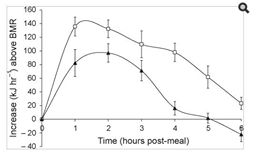Flex Dieting
Andrew Berry / October 14, 2013
When it comes to dieting, there has been a new movement over the past few years called flexible dieting. The supporters of this program propose that it is not the source of the macronutrients that you eat, but only the macronutrient and caloric totals that dictate whether you lose fat or not.
The most popular form of this dieting method is called IIFYM. IIFYM stands for ‘if it fits your macros.” There is even a website (www.iifym.com) complete with a macronutrient calculator for you. As long as you meet your macronutrient and caloric totals, you will continue to lose weight regardless of where those foods are coming from. That means you could eat pancakes, ice cream, and prime rib as long as you meet your predetermined macronutrient goals.
That might work initially for some but research is showing otherwise. According to an article in Scientific American magazine, “Everything you know about calories is wrong,” there are differences in the way our bodies process different foods. (1) Food transport time, energy lost in digestion, and even the species of bacteria in your gut can influence how much of the food you just ate stays with you and how much is lost either in metabolism or excretion.
The articles author, Rob Dunn, a biologist from North Carolina State University has spent his career studying things like food transport, digestion, and efficiency. Some of his current research deals reveals that the amount of calories we extract from food depends on which species of food we eat, how the food was prepared, what bacteria live in our digestive tract, and individual TEF’s (thermic effect of food).
Dunn’s research collaborates with a research article from Food and Nutrition Research in 2010 that studied the differences in BMR (basal metabolic rate) following a natural whole foods meal versus a highly processed meal. (2) Two groups were divided and fed either a whole foods meal or a highly processed meal. Both meals were iso-caloric and similar in macronutrient content. The group eating the whole foods meal had almost a two-fold increase in BMR over the processed meals group during the postprandial period.

Another area of research presented in Dunn’s article deals with the discrepancy in the Atwater system which is currently used to determine the available energy from foods. When you look at a food label on the back of a food item, you will see calorie and macronutrient values determined from the Atwater system. This system was developed in the early 1900’s and is still used today.
In a study done by the USDA at the Beltsville Human Nutrition Research Center in Maryland, researchers studies the difference in the Atwater predicted energy content of almonds in the human diet. The researchers measured the actual content over an 18 day period via fecal and urinary samples and determined that there was a significant (32%) discrepancy in the energy available from what was predicted and what was actually in the almonds. (3)
I think these two studies show that the type of food is just as important as the amount. Look for more about this topic in a full article coming soon.
1. Dunn, Rob. “Everything you know about calories is wrong,” Scientific American. Vol. 309; 3. September, 2013. Pgs. 57-59.
2. Barr, Sadie B., Wright, Jonathan C., “Postprandial energy expenditure in whole-food and processed-food meals: implications for daily energy expenditure,” Food and Nutrition Research. Vol. 54, 2010.
3. Novotny JA, Gebauer SK, Baer DJ. “Discrepancy between the Atwater factor predicted and empirically measured energy values of almonds in human diets.” American Journal of Clinical Nutrition. 2012 Aug;96(2):296-301
